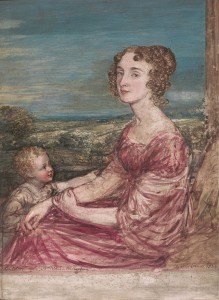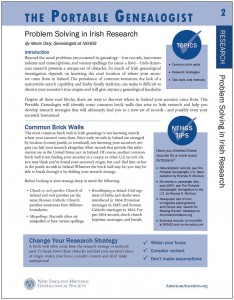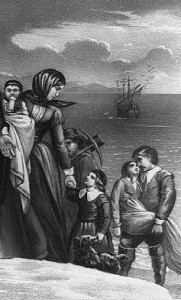We recently implemented a new feature in the NEHGS library catalog that will make it easier to keep track of library resources that are relevant to your research. The function is called “My Lists,” and it allows you to save lists of titles to your NEHGS library account for as long as desired. The records will be available whenever and wherever you log into your account, and you can view, print, email, or save the list with your computer or mobile device at any time. Continue reading New “My Lists” in the NEHGS Library Catalog
Category Archives: Research Methods
King Richard III’s Matrilineal Kin

News of King Richard III’s reburial last week was interesting, especially the stories regarding descendants of the King’s sister, who each placed a white rose (the House of York’s emblem) on his coffin. These four living relatives (Canadian siblings Michael, Jeff, and Leslie Ibsen, and Australian-born Wendy Duldig) have been called Richard’s “closest descendants” in various news articles. Let’s examine this claim. Continue reading King Richard III’s Matrilineal Kin
A helping hand

Before I began researching my ancestry, I was overwhelmed by the undertaking. It seemed like an impossible task that would take up all my time — trying to make sense of all those great-great-great-greats with their shifting residences, repeating names, and overlapping dates. I’ve always been bad with numbers and dates, and tend to be distracted by anything new and exciting, so my past attempts at uncovering information about my ancestors have resulted in a confusing game of Internet hopscotch through random records I couldn’t really understand concerning people to whom I may or may not have been related. I had convinced myself that I was uniquely ill equipped for genealogical research.
But kind fate reached out a helping hand in the form of my friend and colleague Chris Child. Not only is Chris a really nice guy, he’s one of the smartest people I’ve ever met, and a legend in the genealogical community. He offered to help me begin and guide me through my research. I accepted immediately, before he could change his mind. Continue reading A helping hand
Census records for tracking economic mobility

For a school assignment, my daughter had to identify a family member who rose in social and economic class through means of employment and education opportunities. I immediately thought of her great-great-grandparents, Louis and Emma. Each had emigrated from Austria to New York, where they met, married, and had ten children, including her great-grandmother, Anna. I knew that the family had lived on the Lower East Side of Manhattan, and that Louis had been a tailor in a factory. But I did not really know much beyond that except that at some point the family had moved out of the tenements, and some of the Anna’s siblings had professional occupations. I suggested that we examine census records to find out more. Continue reading Census records for tracking economic mobility
Church records in early New England research

Church records can be a valuable resource when vital records fall short. NEHGS has a large collection of published church records for New England and throughout the United States. For learning more about the Church family of Plymouth County, Massachusetts, Congregational Church records, held by the Congregational Library and Archives on Beacon Street in Boston, have also proved especially helpful.
A Caleb Church of Hanover purchased land in Rochester, Plymouth, Massachusetts in 1770, went on to marry a woman named Hannah Pool in 1772, and died in 1827. However, the ancestry of Caleb Church was a mystery. Though he was listed in the 1770 land record as being originally “of Hanover,” there was no birth record for Caleb Church in the Hanover Vital Records.[1] Continue reading Church records in early New England research
A surprising brush with history

My husband inherited several dozen Civil War–era letters from his great-great-grandmother Susan (Berry) Dill and her daughter, Ida Alice Dill, who lived in Sangamon and Christian Counties, Illinois. Ida married Frank Stratton, the brick wall in my husband’s ancestry. One day, in frustration at not finding anything about Frank, I took to Google and entered a string of names and dates from the letters: George Elizabeth Susan Benjamin Berry Christian County Illinois 1850 1860—something like that. If no clue to Frank turned up, I figured, I would learn more about the Berrys. And indeed I did. Continue reading A surprising brush with history
Resources for World War I research

One of the things I enjoy most about family research is to go beyond locating ancestors’ names and the dates of birth and death, and find out as much as I can to develop a picture of their lives. I want to know where they lived, what they did for a living, what their hobbies were, etc. I also like to try to place my ancestors in a broader historical context.
Like many of you, I have connected ancestors to World War I. When approaching a topic as daunting and nuanced as the Great War, I figure that one can never know enough. Luckily, there are a wide variety of resources available. Here are some my favorites: Continue reading Resources for World War I research
Researching your Irish ancestors
 It’s St. Patrick’s Day! What better time to review NEHGS resources — both in print and online — that can help you research your Irish ancestors? Irish research offers particular challenges, largely owing to the destruction of many records in a 1922 fire at the Public Record Office in Dublin.
It’s St. Patrick’s Day! What better time to review NEHGS resources — both in print and online — that can help you research your Irish ancestors? Irish research offers particular challenges, largely owing to the destruction of many records in a 1922 fire at the Public Record Office in Dublin.
One great resource for getting you started is the Portable Genealogist Problem Solving in Irish Research, written by Marie E. Daly (who herself is a valuable NEHGS resource for Irish research). Marie notes that “the prevalence of common surnames, the lack of a nationwide search capability, and faulty family tradition can make it difficult to discern your ancestor’s true origins and will give anyone a genealogical headache.” To help readers, the guide identifies common brick walls that you might encounter and helps you identify research strategies. For instance, a little checklist notes records for determining a more exact birthplace. The guide also addresses some common assumptions that prevent researchers from moving forward with their Irish research. Continue reading Researching your Irish ancestors
Dowry versus Dower Right

Family historians use a variety of records, some of which require some understanding of legal terms. And when it comes to land records, one term that is very often misunderstood is dower. Many look at that word and think of dowery. While both terms have to do with women, marriage, and property, they have different meanings. Continue reading Dowry versus Dower Right
Many hands, many cradles

I’m in the middle of doing some research for a lecture that I’ll be giving in April at NEHGS entitled “The Hand that Rocked the Cradle.” It will use an informal statistical sampling of the women who have been included in the Early New England Families Study Project so far to see if we can form any general pictures about these ladies and their families. Preliminary statistics are interesting.
The gross totals: 88 women who had 116 husbands, 608 children (an average of about 7 each) and 174 step-children. I think that is what they call “populating a wilderness!”
On average these women were born about 1620, came to New England about 1636 (about age 16), were married for the first time about 1640 (age 20), and lived to about 1682 (age 62). Those who had multiple marriages averaged age 41 for the second marriage (22 women), 46 for the third (4 women), and 42 for the fourth (1 woman).
The youngest at first marriage was 15, oldest at first marriage, 32. The woman who lived to the greatest age was 97, and the one who died the youngest was 21. Continue reading Many hands, many cradles